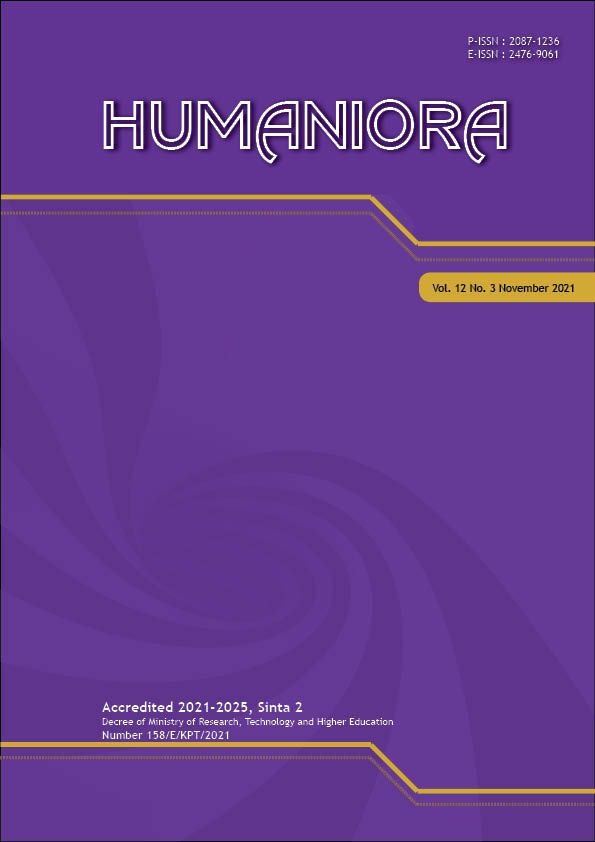Working from Home during the COVID-19 Pandemic: What is the Impact on Employees’ Psychological Meaningfulness, Safety and Availability?
DOI:
https://doi.org/10.21512/humaniora.v12i3.7062Keywords:
work-from-home, COVID-19 pandemic, psychological meaningfulness, emplyoyee safety, employee availabilityAbstract
The research aimed to explore the relation of work-home and home-work interactions on employees’ psychological condition while working from home during the COVID-19 pandemic. The coronavirus (COVID-19) pandemic had led various organizations to implement work-from-home measures. This rapid change in working arrangements might affect employees’ psychological condition as they navigate both their work and home responsibilities at the same time and place. The research involved 2.288 employees at one government institution in Indonesia. Data were collected in April 2020, using the web-based tool Survey Monkey. The data were analyzed by logistic regression analysis. The results show that Negative Work–Home Interactions (NWHI) are significantly associated with psychological meaningfulness and psychological safety, while Negative Home–Work Interactions (NHWI) are significantly associated with the three psychological dimensions. Positive Work–Home Interactions (PWHI) are significantly associated with psychological safety, while Positive Home–Work Interactions (PHWI) are significantly associated with the three psychological dimensions. Based on the results, it can be concluded that positive and negative experience that happens at work spill over to the home domain and vice versa, which could, in turn, impact on employee sense of meaningful, safety, and sense of having the physical, emotional, and psychological resources to perform tasks at work during working from home. Therefore, organizational support is important in maintaining employees’ psychological condition while working from home during the pandemic.
References
Abrams, Z. (2020). Psychologists’ advice for newly remote workers. Retrieved from https://www.apa.org/news/apa/2020/03/newly-remote-workers.
APS (Australian Psychological Society). (2020). Maintaining employee engagement during COVID-19. Retrieved from https://www.psychology.org.au/getmedia/5c7bd7ac-7229-41fa-867b-68a265fb237f/APS-COP-IS-COVID-19-Employee-engagement-P1.pdf.
Atalan, A. (2020). Is the lockdown important to prevent the COVID-9 pandemic? Effects on psychology, environment, and economy-perspective. Annals of Medicine and Surgery, 56, 38-42. https://doi.org/10.1016/j.amsu.2020.06.010.
Cai, Z., Huang, Q., Liu, H., & Wang, X. (2018). Improving the agility of employees through enterprise social media: The mediating role of psychological conditions. International Journal of Information Management, 38(1), 52-63. https://doi.org/10.1016/j.ijinfomgt.2017.09.001.
Carvalho, V. S., Chambel, M. J., Neto, M., & Lopes, S. (2018). Does work-family conflict mediate the associations of job characteristics with employees’ mental health among men and women? Frontiers in Psychology, 9, 1-12. https://doi.org/10.3389/fpsyg.2018.00966.
Chong, S., Huang, Y., & Chang, C. D. (2020). Supplemental material for supporting interdependent telework employees: A moderated-mediation model linking daily COVID-19 task setbacks to next-day work withdrawal. Journal of Applied Psychology, 105(12), 1408-1422. https://doi.org/10.1037/apl0000843.supp.
Demerouti, E., Bakker, A. B., & Voydanoff, P. (2010). Does home life interfere with or facilitate job performance? European Journal of Work and Organizational Psychology, 19(2), 128-149. https://doi.org/10.1080/13594320902930939.
Demerouti, E., Geurts, S. A. E., & Kompier, M. (2004). Positive and negative workâ€home interaction: Prevalence and correlates. Equal Opportunities International, 23(1/2), 6-35. https://doi.org/10.1108/02610150410787837.
Fairlie, P. (2011). Meaningful work, employee engagement, and other key employee outcomes: Implications for human resource development. Advances in Developing Human Resources, 13(4), 508-525. https://doi.org/10.1177/1523422311431679.
Geurts, S. A. E., Taris, T. W., Kompier, M. A. J., Dikkers, J. S. E., Van Hooff, M. L. M., & Kinnunen, U. M. (2005). Work-home interaction from a work psychological perspective: Development and validation of a new questionnaire, the SWING. Work and Stress, 19(4), 319-339. https://doi.org/10.1080/02678370500410208.
Giorgi, G., Lecca, L. I., Alessio, F., Finstad, G. L., Bondanini, G., Lulli, L. G., Arcangeli, G., & Mucci, N. (2020). COVID-19-related mental health effects in the workplace: A narrative review. International Journal of Environmental Research and Public Health, 17(21), 1-22. https://doi.org/10.3390/ijerph17217857/
Grant, C. A., Wallace, L. M., & Spurgeon, P. C. (2013). An exploration of the psychological factors affecting remote e-worker’s job effectiveness, well-being and work-life balance. Employee Relations, 35(5), 527-546. https://doi.org/10.1108/ER-08-2012-0059.
Hill, C., & Blunn, L. (2018). Personality and work-home interaction among dual-earner couples in South Africa: Testing an actor-partner interdependence model. Journal of Psychology in Africa, 28(6), 435-443. https://doi.org/10.1080/14330237.2018.1539898.
Hosmer, D. W., & Nils, L. H. (2002). Goodness-of-fit processes for logistic regression: Simulation results. Statistics in Medicine, 21(18), 2723-2738. https://doi.org/10.1002/sim.1200.
ILO (International Labour Organization). (2020). ILO monitor: COVID-19 and the world of work. 1st Edition. Retrieved from https://www.ilo.org/global/about-the-ilo/WCMS_738753/lang--en/index.htm.
ITC (International Test Commision). (2017). International test commission guidelines for translating and adapting tests. Retrieved from https://www.intestcom.org/files/guideline_test_adaptation_2ed.pdf.
Jacobs, H. (2013). An examination of psychological meaningfulness, safety, and availability as the underlying mechanisms linking job features and personal characteristics to work engagement. ProQuest Dissertations and Theses. Miami: Florida International University. https://doi.org/10.25148/etd.FI13080518.
Jostell, D., & Hemlin, S. (2018). After hours teleworking and boundary management: Effects on work-family conflict. Work, 60(3), 475-483. https://doi.org/10.3233/WOR-182748.
Kahn, W. A. (1990). Psychological conditions of personal engagement and disengagement at work. Academy of Management Journal, 33(4), 692-724. https://doi.org/10.5465/256287.
Kung, F. Y. H., Kwok, N., & Brown, D. J. (2018). Are attention check questions a threat to scale validity? Applied Psychology, 67(2), 264-283. https://doi.org/10.1111/apps.12108.
Åaba, K., & Geldenhuys, M. (2018). Positive interaction between work and home, and psychological availability on women’s work engagement: A ‘shortitudinal’ study. SA Journal of Industrial Psychology, 44, 1-11. https://doi.org/10.4102/sajip.v44i0.1538.
Maruyama, T., & Tietze, S. (2012). From anxiety to assurance: Concerns and outcomes of telework. Personnel Review, 41(4), 450-469. https://doi.org/10.1108/00483481211229375.
May, D. R., Gilson, R. L., & Harter, L. M. (2004). The psychological conditions of meaningfulness, safety, and availability and the engagement of the human spirit at work. Journal of Occupational and Organizational Psychology, 77(1), 11-37. https://doi.org/10.1348/096317904322915892.
Michael-Tsabari, N., Houshmand, M., Strike, V. M., & Treister, E. D. (2020). Uncovering implicit assumptions: Reviewing the work–family interface in family business and offering opportunities for future research. Family Business Review, 33(1), 64-89. https://doi.org/10.1177/0894486519899789.
Mostert, K. (2006). Work-home interaction as partial mediator between job resources and work engagement. Southern African Business Review, 10(2), 53-74. https://doi.org/10.1211/ijpp.15.3.0011.
Munn, S. L. (2013). Unveiling the work-life system: The influence of work-life balance on meaningful work. Advances in Developing Human Resources, 15(4), 401-417. https://doi.org/10.1177/1523422313498567.
Oakman, J., Kinsman, N., Stuckey, R., Graham, M., & Weale, V. (2020). A rapid review of mental and physical health effects of working at home: How do we optimise health? BMC Public Health, 20(1), 1-14. https://doi.org/10.1186/s12889-020-09875-z.
Obrenovic, B., Jianguo, D., Khudaykulov, A., & Khan, M. A. S. (2020). Work-family conflict impact on psychological safety and psychological well-being: A job performance model. Frontiers in Psychology, 11, 1-18. https://doi.org/10.3389/fpsyg.2020.00475.
Palumbo, R. (2020). Let me go to the office! An investigation into the side effects of working from home on work-life balance. International Journal of Public Sector Management, 33(6-7), 771-790. https://doi.org/10.1108/IJPSM-06-2020-0150.
Paulson, D., & Leuty, M. E. (2016). Dispositional coping, personality traits, and affective style relating to conflict between work and family domains. Journal of Family and Economic Issues, 37(4), 519-539. https://doi.org/10.1007/s10834-015-9470-3.
Peng, C. Y. J., Lee, K. L., & Ingersoll, G. M. (2002). An introduction to logistic regression analysis and reporting. Journal of Educational Research, 96(1), 3-14. https://doi.org/10.1080/00220670209598786.
Podsakoff, P. M., MacKenzie, S. B., & Podsakoff, N. P. (2012). Sources of method bias in social science research and recommendations on how to control it. Annual Review of Psychology, 63, 539-569. https://doi.org/10.1146/annurev-psych-120710-100452.
Rothmann, S., & Baumann, C. (2014). Employee engagement: The effects of work-home/home-work interaction and psychological conditions. South African Journal of Economic and Management Sciences, 17(4), 515-530. https://doi.org/10.4102/sajems.v17i4.419.
SolÃs, M. S. (2016). Telework: Conditions that have a positive and negative impact on the work-family conflict. Academia Revista Latinoamericana de Administracion, 29(4), 435-449. https://doi.org/10.1108/ARLA-10-2015-0289.
Spector, P. E. (2019). Do not cross me: Optimizing the use of cross-sectional designs. Journal of Business and Psychology, 34(2), 125-137. https://doi.org/10.1007/s10869-018-09613-8.
Spector, P. E., Cooper, C. L., Poelmans, S., Allen, T. D., O’Driscoll, M., Sanchez, J. I., Siu, O. L., Dewe, P., Hart, P., Lu, L., De Moraes, L. F. R., Ostrognay, G. M., Sparks, K., Wong, P., & Yu, S. (2017). A cross-national comparative study of work-family stressors, working hours, and well-being: China and Latin America versus the anglo world. In International Human Resource Management: From Cross-Cultural Management to Managing a Diverse Workforce, (pp. 257–280). London: Routledge.
Taber, K. S. (2018). The use of Cronbach’s Alpha when developing and reporting research instruments in Science education. Research in Science Education, 48(6), 1273-1296. https://doi.org/10.1007/s11165-016-9602-2.
Tehseen, S., Ramayah, T., & Sajilan, S. (2017). Testing and controlling for common method variance: A review of available methods. Journal of Management Sciences, 4(2), 142-168. https://doi.org/10.20547/jms.2014.1704202.
Thulin, E., Vilhelmson, B., & Johansson, M. (2019). New telework, time pressure, and time use control in everyday life. Sustainability (Switzerland), 11(11), 1-17. https://doi.org/10.3390/su11113067.
Vaziri, H., Casper, W. J., Wayne, J. H., & Matthews, R. A. (2020). Changes to the work-family interface during the COVID-19 pandemic: Examining predictors and implications using latent transition analysis. Journal of Applied Psychology, 105(10), 1073-1087. https://doi.org/10.1037/apl0000819.
Verweij, H., van Hooff, M. L. M., van der Heijden, F. M. M. A., Prins, J. T., Lagro-Janssen, A. L. M., van Ravesteijn, H., & Speckens, A. E. M. (2017). The relationship between work and home characteristics and work engagement in medical residents. Perspectives on Medical Education, 6(4), 227-236. https://doi.org/10.1007/s40037-017-0364-y.
Vyas, L., & Butakhieo, N. (2020). The impact of working from home during COVID-19 on work and life domains: An exploratory study on Hong Kong. Policy Design and Practice, 4(1), 1-18. https://doi.org/10.1080/25741292.2020.1863560.
WHO (World Health Organization). (2020). Mental health & COVID-19. Retrieved from https://www.who.int/teams/mental-health-and-substance-use/covid-19
WHO (World Health Organization). (2021). Weekly Operational Update on COVID-19. Retrieved from https://www.who.int/publications/m/item/weekly-update-on-covid-19---16-october-2020
Xiao, Y., Becerik-Gerber, B., Lucas, G., & Roll, S. C. (2021). Impacts of working from home during COVID-19 pandemic on physical and mental well-being of office workstation users. Journal of Occupational and Environmental Medicine, 63(3), 181-190. https://doi.org/10.1097/JOM.0000000000002097.
Downloads
Published
How to Cite
Issue
Section
License
Copyright (c) 2021 Siti Fani Daulay, Martina Dwi Mustika

This work is licensed under a Creative Commons Attribution-ShareAlike 4.0 International License.
Authors who publish with this journal agree to the following terms:
a. Authors retain copyright and grant the journal right of first publication with the work simultaneously licensed under a Creative Commons Attribution License - Share Alike that allows others to share the work with an acknowledgment of the work's authorship and initial publication in this journal.
b. Authors are able to enter into separate, additional contractual arrangements for the non-exclusive distribution of the journal's published version of the work (e.g., post it to an institutional repository or publish it in a book), with an acknowledgment of its initial publication in this journal.
c. Authors are permitted and encouraged to post their work online (e.g., in institutional repositories or on their website) prior to and during the submission process, as it can lead to productive exchanges, as well as earlier and greater citation of published work.
USER RIGHTS
All articles published Open Access will be immediately and permanently free for everyone to read and download. We are continuously working with our author communities to select the best choice of license options, currently being defined for this journal as follows: Creative Commons Attribution-Share Alike (CC BY-SA)




















